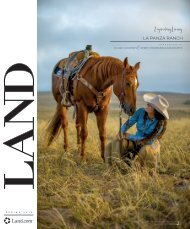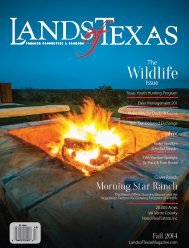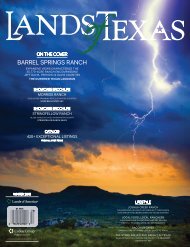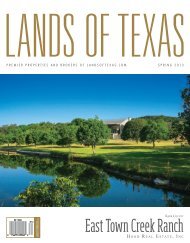•Spring 2017
•Spring 2017
•Spring 2017
You also want an ePaper? Increase the reach of your titles
YUMPU automatically turns print PDFs into web optimized ePapers that Google loves.
West Coast<br />
CONTRIBUTION FROM CALIFORNIA OUTDOOR PROPERTIES<br />
In response to increased global demand for healthy, nutrient-rich<br />
nuts, much of California’s irrigated pastureland has been repurposed<br />
over the past two decades to create orchards growing almonds,<br />
walnuts and pistachios. Almond acreage alone has doubled over<br />
the last 20 years, according to the Almond Board of California, an<br />
industry advocacy group with more than a million acres currently<br />
devoted to the crop. In 2011, the value of the California almond<br />
harvest surpassed that of the state’s grape output, putting almonds<br />
second only to dairy products among California’s top commodities.<br />
Land broker Todd Renfrew, owner of California Outdoor Properties,<br />
headquartered in Vacaville, Calif., says the trend has been a<br />
dominant theme in the state’s agricultural real estate market.<br />
“A perfect example is a ranch with irrigated pasture on which<br />
you’re running cattle,” he says. “You have the grass, you have<br />
the water, you have the soil. Given the demand for orchard<br />
ground, though, those same resources can be put to use<br />
differently, and you have a much larger income stream.”<br />
Renfrew specializes in selling farms and ranches throughout<br />
California. The pasture-to-orchards trend, he explains, has<br />
played out statewide, most visibly in the agriculture-oriented<br />
Central Valley. Long one of the world’s most productive farming<br />
regions, producing everything from tomatoes to cotton, the valley<br />
is now home to more than 6,000 almond growers who, according<br />
to the United Nations’ Food and Agriculture Organization,<br />
produce 60 percent of the world’s supply of the nut. In an effort<br />
to meet global demand, many growers have expanded their<br />
operations beyond the flat farm ground traditionally occupied by<br />
orchards, planting trees in surrounding lowland hills.<br />
“Demand has driven the switchover from pasture to orchards,”<br />
Renfrew says. “There’s been a high demand for almonds, particularly<br />
in the Asian market—India and China. There aren’t that many areas in<br />
the world that can grow almonds. California’s one of them.”<br />
Despite its recent dominance in the ag market, though, the trend<br />
has shown signs of slowing. Prices for orchard ground have<br />
begun to come down, and urgency among buyers has calmed<br />
in comparison to the activity of recent years. “There’s still a big<br />
demand for almond and walnut trees,” Renfrew explains. “But<br />
buyers aren’t willing to pay as much as they have been paying.”<br />
Still, California orchard properties continue to command serious<br />
money. A buyer selecting from currently available inventory might<br />
expect to pay between $16,000 and $60,000 per acre.<br />
Renfrew identifies other trends impacting the California land market:<br />
an increased use of mechanical harvesters raising efficiencies,<br />
and thereby profits, in the grape and olive industries; and ongoing<br />
interest among landowners in pursuing conservation easements. It<br />
is the recent break in California’s five-year drought, though, that has<br />
landowners, investors and brokers feeling most enthusiastic.<br />
“In the last few years, many properties still had the soil, but not<br />
the water,” Renfrew says. “Landowners drilled more wells, going<br />
deeper and deeper, which impacted the water table. In 2016,<br />
we had a tremendously wet year. The dams are full, so it’ll be<br />
interesting. There’s some question as to whether some of these<br />
orchards have been planted in areas where the water table might<br />
come up, and whether that will have an impact on the trees. Still,<br />
the rain we’ve had has people excited, and we’re optimistic about<br />
the market.”<br />
Lands of<br />
yesterday may not,<br />
or will not, be the<br />
lands of tomorrow.<br />
Lands of yesterday may not, or will not, be the lands of tomorrow.<br />
It is important for all of us to work towards this balance of wildlife<br />
and production. Many times we see these two collide and not work<br />
together. This, however, does not have to be the case. I am lucky<br />
to work for companies who care about the land, the landscape<br />
and its people. It is important to always leave the land better that<br />
you found it. That is whether you own it or are just visiting. I have<br />
been reading the horror stories from the Midwest fires in Kansas,<br />
Nebraska and Oklahoma and I feel for those passionate farmers<br />
and ranchers dealing with death and devastation. I pray for those<br />
families who have lost loved ones and look towards the spring and<br />
greener grass.<br />
The constant evolution of these properties and knowing the market<br />
trends and potential valuation is what our team of licensed land<br />
brokers and agents can offer our clients. When you look to buy<br />
real estate, keep in mind that what you purchase today could be<br />
modified and enhanced for tomorrow—and might just help you<br />
keep it for generations to come. °<br />
LAND.COM • LEGENDARY LIVING<br />
35


















